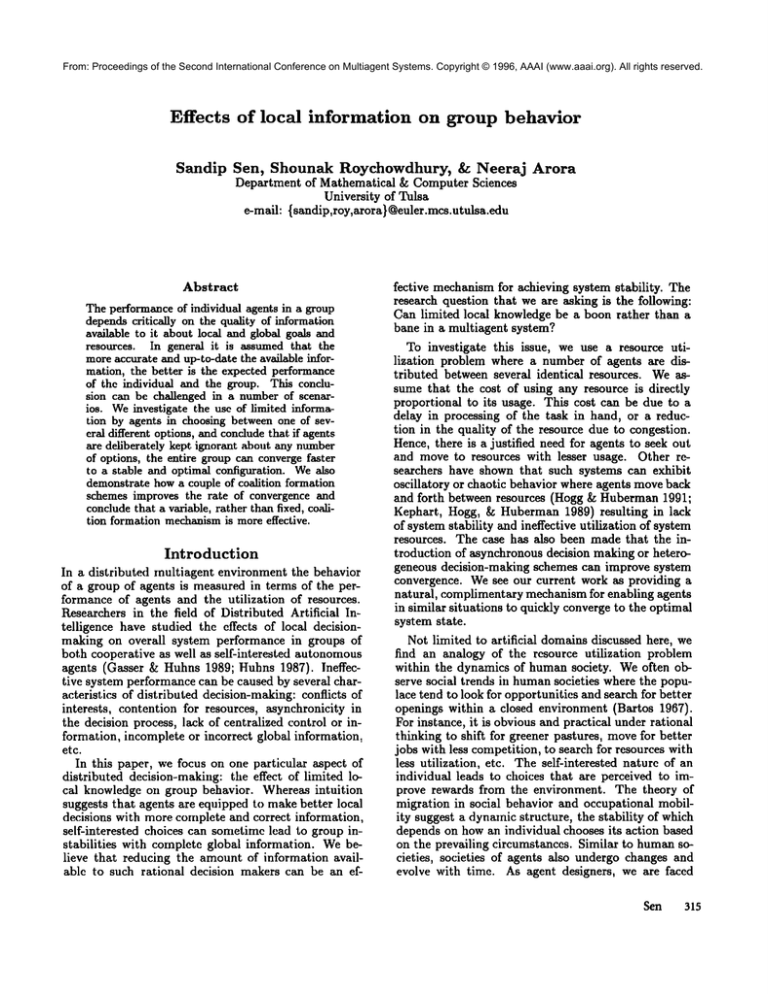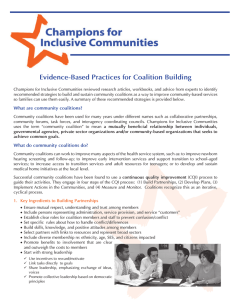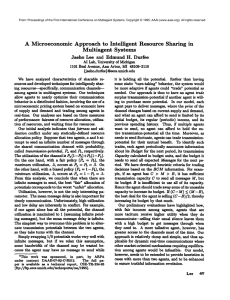
From: Proceedings of the Second International Conference on Multiagent Systems. Copyright © 1996, AAAI (www.aaai.org). All rights reserved.
Effects
Sandip
of local
information
on group behavior
Sen,
Shounak
Roychowdhury,
& Neeraj
Department of Mathematical & Computer Sciences
University of Tulsa
e-mall: {sandip,roy,arora} @euler.mcs.utulsa.edu
Abstract
The performanceof individual agents in a group
dependscritically on the quality of information
available to it about local and global goals and
resources. In general it is assumed that the
moreaccurate and up-to-date the available information, the better is the expected performance
of the individual and the group. This conclusion can be challenged in a numberof scenarios. Weinvestigate the use of limited information by agents in choosing between one of several different options, and concludethat if agents
are deliberately kept ignorant about any number
of options, the entire group can converge faster
to a stable and optimal configuration. Wealso
demonstrate howa couple of coalition formation
schemes improves the rate of convergence and
concludethat a variable, rather than fixed, coalition formation mechanismis moreeffective.
Introduction
In a distributed multiagent environment the behavior
of a group of agents is measured in terms of the performance of agents and the utilization of resources.
Researchers in the field of Distributed Artificial Intelligence have studied the effects of local decisionmaking on overall system performance in groups of
both cooperative as well as self-interested autonomous
agents (Gasser & Huhns 1989; Huhns 1987}. Ineffective system performance can be caused by several characteristics of distributed decision-making: conflicts of
interests, contention for resources, asynchronicity in
the decision process, lack of centralized control or information, incomplete or incorrect global information,
etc.
In this paper, we focus on one particular aspect of
distributed decision-making: the effect of limited local knowledge on group behavior. Whereas intuition
suggests that agents are equipped to make better local
decisions with more complete and correct information,
self-interested choices can sometimelead to group instabilities
with complete global information. Webelieve that reducing the amount of information availablc to such rational decision makers can be an ef-
Arora
fective mechanismfor achieving system stability. The
research question that we are asking is the following:
Can limited local knowledge be a boon rather than a
bane in a multiagent system?
To investigate this issue, we use a resource utilization problem where a number of agents are distributed between several identical resources. Weassume that the cost of using any resource is directly
proportional to its usage. This cost can be due to a
delay in processing of the task in hand, or a reduction in the quality of the resource due to congestion.
Hence, there is a justified need for agents to seek out
and move to resources with lesser usage. Other researchers have shown that such systems can exhibit
oscillatory or chaotic behavior where agents moveback
and forth between resources (Hogg & Huberman 1991;
Kephart, Hogg, ~ Huberman 1989) resulting in lack
of system stability and ineffective utilization of system
resources. The case has also been made that the introduction of asynchronous decision making or heterogeneous decision-making schemes can improve system
convergence. Wesee our current work as providing a
natural, complimentary mechanismfor enabling agents
in similar situations to quickly converge to the optimal
system state.
Not limited to artificial domainsdiscussed here, we
find an analogy of the resource utilization problem
within the dynamics of human society. Weoften observe social trends in humansocieties where the populace tend to look for opportunities and search for better
openings within a closed environment (Bartos 1967).
For instance, it is obvious and practical under rational
thinking to shift for greener pastures, movefor better
jobs with less competition, to search for resources with
less utilization, etc. The self-interested nature of an
individual leads to choices that are perceived to improve rewards from the environment. The theory of
migration in social behavior and occupational mobility suggest a dynamicstructure, the stability of which
depends on howan individual chooses its action based
on the prevailing circumstances. Similar to humansocieties, societies of agents also undergo changes and
evolve with time. As agent designers, we are faced
Sen
315
From: Proceedings of the Second International Conference on Multiagent Systems. Copyright © 1996, AAAI (www.aaai.org). All rights reserved.
with the problem of developing decision mechanisms
that allow agent societies to stabilize in states where
system resources are effectively utilized. In this paper, we consider agent societies where agents decide
on their social mobility based only on their perception
of the current state of the world. This assumption of
relying only on the current state and ignoring the effects of past history on decision makingis also used in
Markovian analysis (Howard 1971).
This study attempts to verify the following conjecture: limited knowledge of the environment can be beneficial for an agent in comparison to complete global
knowledge. We present a decision mechanism to be
used by individual agents to decide whether to continue using the same resource or to relinquish it in
the above-mentioned resource utilization problem. We
show that a spatially local view of an agent can be
effectively used in a decision procedure that produces
stable allocation of agents to an optimal global state
in terms of effective resource utilization. Experimental results showthat increasing the information available to an agent increases the time taken to reach the
desired equilibrium state. Weprovide a probabilistic
analysis explaining this phenomcna. Wcfurther plan
to study the effects of varying amounts of information
on the convergencc process of these agent groups.
Related
Work
Hogg and Huberman (Hogg & IIuberman 1991) have
analyzed a resource utilization problem similar to the
one mentioned in the previous section to study effects of local decisions on group behavior (Hogg
Huberman 1991; Kephart, Ilogg, & Huberman 1989).
Kephart et al. (Kephart, IIogg, & Huberman 1989)
show how system parameters like decision rate can produce stable equilibria, dampedoscillations, persistent
oscillations, or can burst into a chaotic regime. They
also provide an analysis of how agents that monitor
system behavior and accordingly adjust their pcrformazlce can bring the system closer to a stable behavior.
IIogg and Huberman (Hogg & Huberman 1991) present
a robust procedure for suppressing system oscillations
using a reward mechanism based on performance.
Weshare their motivation of achieving stability in
a multiagent system when individual agents arc making decisions based on self-interest.
However,whereas
they are interested in investigating decision procedures
that lead to heterogeneity in agent types, we focus our
efforts on identifying a simple decision procedure that
can be used by all agents but wouldstill lead to stable
systems. On another note, we are particularly interested in evaluating the effects of agent decisions based
on limited system knowledgeon tile stability of the system. Thus we have chosen to investigate systems with
relatively larger mlmber of resources as compared to
others.
We should also clarify that various other forms
of heterogeneity including asyndlronicity of decision
316
ICMAS-96
@ @ Q
Figure 1: Agents sharing resources.
making, different communicationdelays, different decision algorithms, etc. will help speed up convergence
and attain group stability.
Our purpose in this paper, is to investigate the conjecture that access to less
global information can help agents achieve stability under certain situations. It should be noted that because
local information is different for different physically
distributed agents, limiting agent decisions to the use
of local information only provides another source of
heterogeneity in the system.
The
Model
In this section we present a simple model of agents
sharing a set of identical resources as shownthe Figure 1. There are magents and n identical resources. At
any time instant, an agent use only one resource, and
over time tries to moveto a resource that is less used
by other agents. In this study, we show that when
an agent has less knowledge about the utilization of
each resource in the resource set, the contention for
resources decreases and results in quicker convergence
to stable resource usage.
At present we model the knowledge of an agent
about the resources by using an r-window. An rwindow is a window through which an agent can see
which of the resources amongthe resource set it should
look for before making a decision. At each time step
each agent has to maketile following decision: whether
it should continue to use the present resource or should
it movcto another one with less utilization. If agent.
ak is currently using resource i, then it will consider a
nmveto one of the resources in it’s r-window(resource
in the vicinity of the current resource).
The model makes a few basic assumptions. We~msumethat that all resources are equivalent. Moreover,
resources are neither introduced nor eliminated during
the life time of agents. Similarly all agents remain ax:tive and they make thcir decisions synchronously. All
agents retain the same r-window size during the process of decision making. The probability of an agent
to shift from the current resource to another resource
is inversely proportional to the difference of the usage
of these two resource.
From: Proceedings of the Second International Conference on Multiagent Systems. Copyright © 1996, AAAI (www.aaai.org). All rights reserved.
v
li-2
I
i
i-I
i+!
¥
V
i+2_1
-2
r-window
=5
i-!
i
r-window
=5
i+!
i+2,It
Figure2: Resourcei has d agentsmore thanevery
otherresource
in itsr-window.
Figure 3: Resource i has d agents less than every other
resource in the r-window.
We now discuss the decision procedure we use to
determine the resource to be used by an agent in the
next time step. It can be shown that a deterministic and greedy decision procedure of choosing the resource with the lowest utilization in the r-windowwill
lead to system oscillations. Hence, we are motivated to
use a probabilistic decision procedure. The particular
procedure that we use first calculates the probability
of moving to each of the resources in the r-window,
and then normalizes theses values by the corresponding sum. The probability of an agent that decides to
continue to use the same resource i is given by:
agents are using that resource at a given instance of
time. Let X be a random variable corresponding the
number of agents who will not leave the resource in
the next time step. Therefore, values for X follow a
binomial distribution i with probability Pr(i, i). The
expected value of X is therefore given by:
f,i :"
1
.,-o,
1 + rexp a
(1)
where ri is the number of agents currently using resource i (this is also the utilization of that resource),
and % a, and/~ are control parameters. On the other
hand, the probability of moving to another resource
j ~ i is given by:
Ifij
=
0
1
ri
-0
1-1-1"exp
ifjEWi&r~>rj,
-7
otherwise,
(2)
where Wi are the resources accessible to agent using
resource i. Now,the probability that an agent a~ occupying a resource i will occupya resource j in the next
time step is given by normalizing the above terms:
Pr(i,j) -- y.j f~j
flj "
(3)
Our conjecture for the behavior of the group is: the
larger the r-window, the lesser is the stability of the
system, and it takes more time to reach an optimal
equilibrium state. This slower convergence can be explained by a probabilistic analysis. Consider a resource
i which has higher load than the surrounding resources
(as shown in the Figure 2). Wefurther assume that
E[X] = nPr(i, i),
(4)
and the variance of X is given by:
Vat[X] = nPr(i, i)(1 - Pr(i, i)).
(5)
Similarly, as the Figure 3 shows, the resource i is being
less utilized when compared with its neighbors. Obviously there will be a tendency of an agent who is
currently not using i to move to resource i. Let Y be
the random variable corresponding to the number of
agents who will moveinto resource i in the next time
step. Therefore values for that Y follow a binomial distribution with the probability }-’]~j#i Pr(j, i). Wecan
also think of Y as a sum of several independent binomially distributed random variables, Yji, where Y
corresponds to the number of agents who will move
into resource i from resource j in the next time step.
]~i has an expected value of nPr(j, i) and a variance of
nPr(j, i)(1 - Pr(j, i)). Therefore, the expected values
of Y is given by:
E[Y] = ~ nPr(j, i).
j#i
(6)
And the corresponding variance is:
Vat[Y] = ~ nPr(j, i)(1 - Pr(j,
(7)
Let us now analyze the implications of these analysis. Figure 4 plots the expressions in (4) and (5)
different d values and different r-window sizes. Figure 4 reveals a very interesting phenomena.For large
window sizes, the variance of the number of agents
staying in the resource decreases as the difference between the utilization of the current resource usage and
Sen
317
From: Proceedings of the Second International Conference on Multiagent Systems. Copyright © 1996, AAAI (www.aaai.org). All rights reserved.
o
d~I-4.
dm2~t":,.
7 -
", ~ "%
¯ ,. ~.. "~,.,
d--4,~ ’, ’% ...
... ,........,....
%’..,.-~:’.-",L
... ~,"
",, ".,....""~. "....
~....~-~,,:~
.’.<’"
",, -...,
\ ",
’,’:","-.
j
"~ a-~ ’.,
J -din7*
,. ".. -.
",, ~ ’%~ ,.
". \ "% "".
d-S~’\’. \
",.,
"~
’,,
j
"-%
"~
1.5
.i
"..
"-..
.
.-....
........
....
-...
"’,.. ¯....... ¯........
\\"., \\
\~.. ".... ".. "-.
-.,,..
k~,,
..... ~’-\
-..
\’....... ".~.~
\’~. -... ~. ....
-...÷
". ........
-
[..
"-,..
...
,.
"%
"...
:: 7; ~..". ~.¯
¯
"...
/:~’i
~\
"~dffi3
"~"-.
"-~
~
""-¯ .:
k’,.’,, ". ¯
,
"’-,÷
/’:
""’-...
"-,
-,~’,~ "..,. \\
".......
"-,, --
~..
-...... ¯ ..............
O.S
i
"-.-.,
_
,1- "’"~’----"""" "-El.. ~.’." ........ W
2
4
6
8
IO
r-window
12
o2
14
4
....
(1
~
]0
I
r-window
,
, -- I~
I
Figure4: Expectationandvarianceof an agent, staying in the current resource(correspondingto Figure2), and
l+d= 10.
t20
¯ *" dfW
llO -
~’/
..’"
.~. d~9
2.5 -
,.
.,"
...." .,
a.’"
..." Wd..
b
/"
..."
~.~
..-’"
.o.""
g()
~0 70 -
1
,.."
~A)-
~.~ e"
.~A)-
30 20 -
0
2
....~" ..."
¯ ~ i, .."
.M"
.o"°
..’"
o’*
~ d~
.....at"
..~"
..." .." ..at" ..~
.F
..
.......
../.’.~" .. "" ..x""
..¢..""......
x-"
. ...Xill4~
....-.""
i -- ~
8
I
10
f-willdC/w
~d=3
S
I’~:
12
¯
~"
/,~
t.5 -
m
/"
f
~’~--’..-"
~¢........... . .-~.......
;
/re"""
--
I -
......-..;...,,<.;....I
.................. -o ....... ...--.........
..- .x."
:
-
..-.....
...-..;....~..
~"’---"’’’’-’~)’--4
6
--.......
iX
-
~
.~’"
I
14
/
~," ,-"’"
-
/"
,,
2
,~ "" ....-’"
~.~
..’"
...
,.-"
.,.."
~t"
.~ -"
~.~ -’"
..~’"
:::*:i.........~
l["’~:’"’TIt-’--’~
6
!
It)
r-wil~dOw
tl=5
~,...
--
o.~.-. Jr" °
...-""
.....4---"
_
.- .i
,.~’"
¯ -°" -..~"A.--’" o..=lie-" .....4,-4
,.X ¢1~4
...""
-
~- d=ll
16
m
ed=l
~
.. 4,-- """i i i i
ii i i
,
12
,
14
,
16
Figure5: Expectationandvarianceof an agent movingto the less used resource(correspondingto Figure3).
the neighboringresourceusages decreu-~es.This means
initially the agentswill quicklyspreadout, but. later
it will havedifficulty to convergewizenall resources
have roughlythe sameutilization. At this point high
variance can again cause someimbalancein the resource usage. Thesituation is precisely the opposite
for small windowsizes: here, the variance decreases
with the decreasingdifference betweenthe currentand
the neighboringresources. This meansthat there will
be a relatively slower convergencetowardsa balanced
distributionof agentsto resources,but there is a continuing pressuretowardsmoreuniformdistribution of
agents to resources. This processis further helpedby
a greater inertia of movingof the currentresourceat
smaller r-windowsizes as seen fromexpected number
of agent plot in Figure 5. A similar phenomena
is
observedin Figure 5 whereweconsider the variance
318
ICMAS-96
in the numberof agents comingto a resource which
is less utilized than the neighboringresources. These
twofigures give a more
formalexplanationof the faster
convergencewith smaUerwindows.Weare currently
performing
a moredetailed analysis of this phenomena.
Results
We assume that the resources ;ire arranged in a ring
and each agent knows the number of agents using
the resource it is using and the neighboring resources
within the r-window to the left. and right. Each time
step consists of all agents making a decision regarding
which resource to use next. In Figure 6 we present
experimental results with 27 agents using 9 resources.
The data for these plots are averaged over 10 random
initial assignments of agents to resources. Starting
from r-window size of 3, as we increase the size of the
From: Proceedings of the Second International Conference on Multiagent Systems. Copyright © 1996, AAAI (www.aaai.org). All rights reserved.
,4OOO
F
3500 -
no-~mLlition
:" --
3000 ?.~00 -
1500 -
1000 -
...-"
.m
..-’"
.--""
500 ........
~-""
............
fixed
-+- .........
variablt~
o--:::::.".Y.:~.-;~--:".-~-:-::-z.T
..........
, 7 --V-------,
3
4
5
6
H
9
WindmvSli~
Figure 6: Numberof steps to convergence for different
R-windowsizes.
window to 9, we observe that the system takes much
more time on the average to stabilize. Figure 7 presents
the numberof agents occupying resource 1 at different
time steps with r-window sizes of 3, 5, 7, and 9 respectively. These figures confirm our experimentation
that together with taking more time to converge, the
variation in the number of agents occupying a given
resource is higher with the larger windowsize.
Our initial experiments, therefore, suggest that
agents converge to a stable state (which is also optimal because agents are equally distributed amongthe
resources) in less number of time steps when they have
relatively less global information.
Forming coalitions
In the previous section, we observed that agents with a
limited view of global scenario converged faster to optimal states. However, this work was based on the assumption that every agent made an individual decision
which was based on the current resource utilizations.
The results showedthat in cases where the window-size
is large the system took significantly longer to converge
(in some cases the system did not converge even after
a large number of time steps). One reason which we
attributed to this delayed convergence was that the individual agent had no information about the decision
of the other agents. As a result, all the agents tried to
move towards the least utilized resource within their
view thus letting the previously under-utilized resource
to becomeover-utilized in the next time step and vice
versa.
Weconjectured that some of the convergence problems mentioned above can be alleviated
by forming
coalitions of agcnts, where agents belonging to a given
coalition will cooperatively decide on their next move.
For exanlple, within any such coalition, agents may
take turns in selecting which resource they are go-
ing to occupy in the next time step and then inform
other agents in the coalition about that decision. Thus,
agents will have more up-to date and accurate information about the likely resource usages in the next time
step, and hence are in a position to make a more effective movementdecision. In the extreme case, if all
agents form one coalition and the R-windowincluded
all resources, each agent will have a complete and correct global information at all times, and the system
will immediately converge if each agent moves to the
least used resource at the time it makes its movement
decision.
We studied two modes of forming coalitions:
in
the first mode agents were randomly partitioned into
equal-sized coalitions before the start of the simulation
and no agents ever changed coalitions (we use a coalition size of 5); in the second form, agents occupying
the same resource at any given time formed a coalition and hence coalitions changed from one time step
to the next. In both the groups, an individual agent’s
decision of moving to a resource is not only based on
the current utilization of the resources within its view
windowbut is also guided by the actual status of that
resource after all the other agents in its group have
decided to moveto a particular resource.
Weran experiments for both these coalition types
by varying the window size and keeping the number
of agents and resources constant. The results of these
experiment averaged over 10 runs are shown in the
Figure 6. The convergence patterns with two types of
coalitions were very similar to the convergence pattern
with no coalitions, i.e., increasing the windowstill resuited in slower convergence. Runs with coalitions,
however, converged faster than runs with no coalitions. This was particularly true for larger window
sizes where runs without coalition often took an extremely long time to converge. In fact, we believe for
larger windowsizes (will require more resources too)
and number of agents, the system may not converge if
someform of coalitions are not used.
Whencomparing the performance of two coalition
types, we find the variable coalitions converge faster
than fixed coalitions. This observation can be explained by two reasons:
¯ Agents belonging to a static coalition may be dispersed over all the resources at any given point in
time. So, the movement decision of any one such
agent may not impact all the other agents in the
coalition (the agent may be moving from and to resources both of which may be outside the windowof
some of the other agents). Hence, only some of the
information that is shared amongthe coalition members is useful. On the other hand, in the variable
coalition case, movementdecisions of any one agent
impacts every other agent in the coalition. Thus, for
same sized coalitions, agents in variable coalitions
take more informed decisions compared to agents in
fixed coalitions.
Sen
319
From: Proceedings of the Second International Conference on Multiagent Systems. Copyright © 1996, AAAI (www.aaai.org). All rights reserved.
10
I0
8 -
--
8 -
h -
0 -
ill
!
f.}
0
/
200
i
,.100
I
600
Time
I
800
|
I (XJO
1200
0
It3
I0
4
4
0
0
200
400
~XJ
Tinl~
800
IG(X)
I2(X)
0
0
I
2{)0
I
400
I
fl{’lO
Tinle
/
8fK)
I
|O(X)
12{XJ
O
2fX)
4(XI
tcKXJ
Tintt,"
X(J4J
IlXIO
I2fX)
Figure 7: System convergence with 27 Agents and 9 resources. From top left in clockwise order we have R-windows
of 3, 5, 9, and 7 respectively.
¯ The size of fixed coalitions is determined a priori:
whereas the size of variable coalition dynamically
changes. The larger the load on a resource, the larger
is the size of the corresponding variable coalition,
and the more informed is the decisions made by corresponding coalition members. IIence, our proposed
variable coalition formation schemeallows agents access to moreinformation precisely whenit is critical.
This allows variable coalitions to converge faster.
The more general lesson from this set of experiments
is that in order for agents to be flexible to changing environmental demands, it is more appropriate to provide
a coalition formation and dissoh]tion mechanismthat
utilizes current problem loads and inter-relationships
between agents. As these critical factors change over
time, it is often myopicto pre-assign the coalition to
which an agent should belong over its lifetime.
320 ICMAS-96
Discussions
To "bury the head in the sand" arid ignore most of I.he
information (in this case of using a small r-window)
does not appear to be a sound principle in general.
However, to observe what neighbors are doing may be
good precept, but to base our decisions closely on what
is happcning anywhere in the whole wide world can be
misleading at times, and call be detrimental in specific
circumstances. One can easily find the effectiveness of
sudl principles in daily chores of our lives. To name
a few: a visit to a ticket countcr, which highway to
take to work, computational jobs waiting in various
queues for their turn to get processed, etc. Similarly,
we bclieve that a homogeneousagent society utilizing a set of limited resources might be able to utilize
their resources efficiently by avoiding complete knowledge about the entire set of resource. Analyzing the
data from these experiments suggests some furLher investigations on the interplay between limited global
knowledgeand group stability. Wediscuss som~"of our
From: Proceedings of the Second International Conference on Multiagent Systems. Copyright © 1996, AAAI (www.aaai.org). All rights reserved.
planned experiments below:
Adaptive agents: Counter to our normal expectations we have shownthat it maybe detrimental to
search far and wide for the best opportunity if everyone is doing the same. In retrospective, an intelligent agent mayadopt an adaptive policy of increasing its information windowuntil it senses an
instability in the system(finds itself jumpingcontinuously from one option to another). At that point
it maybe prudent to reduce the information window. Adaptive policies may use specific dynamic
learning strategies to handle specific problems.For
instance, resource utilization problem might use a
learning strategy which might not be suitable in a
problemwherecommunicationis a critical.
Graded movements: Wecan also model agents with
gradedinertia of rest. Theseagents prefer to shift to
a nearer resource with less utilization rather than to
a moredistant resource with negligible utilization. A
more uniform treatment of this approach would be
to add a notion of stability to the probability calculation, i.e., the further off a resourceis located from
the current resource, the less will be the probability
of makingthe movegiven the same difference in resource utilizations. Agents mayhave large window
size, but is moreand morereluctant to movefurther
away from its current choice. This mechanismassumes a distance metric between choices. A simple
extension to equation (1) can be shownas follows:
f
fij = 0
1
1
1+¢exp(ri--rJ)’/lliJ
Gasser, L., and Huhns,M. N., eds. 1989. Distributed
Artificial Intelligence, volume2 of ResearchNotesin
Artificial Intelligence. Pitman.
Hogg, T., and Huberman,B. A. 1991. Controlling
chaos in distributed systems. IEEETransactions on
Systems, Man,and Cybernetics 21(6). (Special Issue
on Distributed AI).
Howard,R. A. 1971. DynamicProbabilistic Systems,
Volume I: MarkovModels. NewYork, NY: John Wiley g5 Sons, Inc.
Huhns,M., ed. 1987. Distributed Artificial Intelligence. Morgan Kaufmann.
Kephart, J. O.; Hogg, T.; and Huberman,B. A. 1989.
Dynamicsof computational ecosystems: Implications
for DAI.In Huhns,M. N., and Gasser, L., eds., Distributed Artificial Intelligence, volume2 of Research
Notesin Artificial Intelligence. Pitman.
if j E I4~ &ri > rj,
otherwise,
(8)
whereJ~j is the distance betweenresource i and resource j.
Conclusions
In this study we investigated the problemof resource
utilization and global performance based on limited
local information. The agents with a limited view of
global scenario convergedfaster to optimal states. We
provide a probabilistic analysis that sheds somelight
on this interesting phenomenon.
Weargued in favor of
dynamic,rather than static, coalition formation mechanism to improve system performance. Wealso identified future avenuesof workthat will produceadaptive
agents whichperformmoreeffectively than agents with
static strategies.
Acknowledgments: This work has been supported, in part, by aa NSFgrant IPd-9410180.
References
Bartos, O. J. 1967. Simple Modelsof GroupBehavior.
NewYork, NY:ColumbiaUniversity Press.
Sen 321







